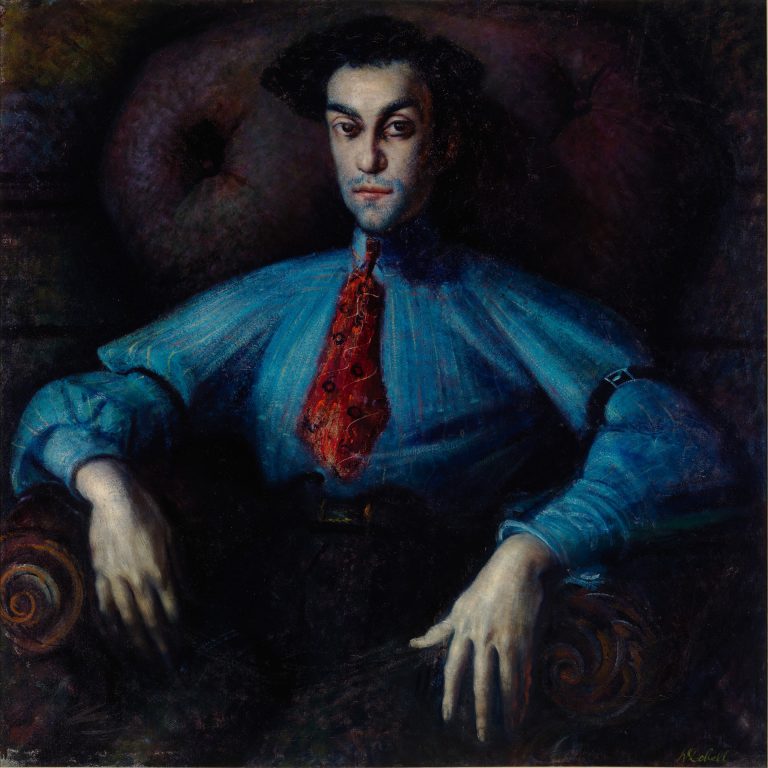We acknowledge the Traditional Owners of the land on which the Queensland Art Gallery | Gallery of Modern Art stands and recognise the creative contribution First Australians make to the art and culture of this country.

William Dobell / Australia 1899–1970 / The Cypriot 1940 / Oil on canvas / 123.3 x 123.3cm / Gift of the Godfrey Rivers Trust through Miss Daphne Mayo 1943 / Collection: Queensland Art Gallery | Gallery of Modern Art / © QAGOMA
William DobellThe Cypriot 1940
Not Currently on Display
William Dobell had an enquiring interest in people and their situations. The Cypriot 1940 is a portrait of Aegus Gabrielides, a Greek Cypriot waiter who worked in a London cafe frequented by Dobell in the 1930s, and who modelled regularly for Dobell and his artist friends. While Dobell’s early sketches portray an unassuming figure, the finished painting presents a far more imposing character, one who regards us with indifference.
Dobell often embellished aspects of his sitter’s appearance to draw out their most distinctive traits. When painting a portrait, he usually completed a series of pencil sketches with them present to capture their key characteristics. He would then embark on a number of small studies in gouache or oil, each reflecting a different mood. His final version of the portrait would be based on the most successful of these preliminary sketches, though he didn’t work directly from them, nor from his model.
When our conservators examined The Cypriot under the microscope and with X-rays, the beginnings of another work — Study for “Boy lounging” 1937, held by the Art Gallery of New South Wales — were revealed underneath.1
Endnotes:
1. Timothy Morrell and John Hook, ‘Two views of Dobell’, in Brought to Light: Australian Art 1850–1965, Queensland Art Gallery, Brisbane, pp.158–63, 1998.
William Dobell was born in Newcastle, New South Wales. He showed early artistic promise, entertaining classmates at Cooks Hill Public School with his sketches. At 14, he began work in a Sydney drafting office and soon moved to the advertising department, where he produced illustrations for newspapers and catalogues.
Dobell took evening classes at the Sydney Art School and, in 1929, won the Society of Artists’ travelling scholarship, which enabled him to live and study in London. This marked a turning point in his life and the experience he gained overseas led to the development of his aesthetic.
On his return to Sydney in 1938, Dobell taught part-time at the East Sydney Technical College. In 1942, he was appointed as an official war artist. Renowned for his insightful portraits, he won the Archibald Prize for portraiture three times — in 1943, 1948 and 1959. He was knighted in 1966.
Discussion Questions
1. What can we learn about the character of the person depicted? Explain how colour and texture has been used to portray this. Why do you think Dobell painted his subject in this manner?
2. Dobell did not simply replicate what he saw in front of him when painting this portrait. Identify the features of Dobell’s portraiture that make it distinctly or uniquely his.
3. The Archibald Prize has a history filled with controversy. Research the competition to discover more about Dobell’s Archibald Prize-winning portraits.
Activities
1. Take a photograph of someone seated like Aegus Gabrielides. Draw a grid over the photo and make a grid to scale on a blank piece of paper. Referencing the photograph, transfer the image onto the grid sheet by drawing one square at a time. Accentuate the particular characteristics of your subject using shading and distorting lines. Complete the grid portrait and paint the work to cover the grid lines.
2. Photograph a member of your family or a friend sitting in a chair. Draw a series of sketches from the photographs, deliberately exaggerating and emphasising a look or expression being conveyed. Working from your favourite sketch, create a portrait and consider using a dark background like Dobell’s The Cypriot.